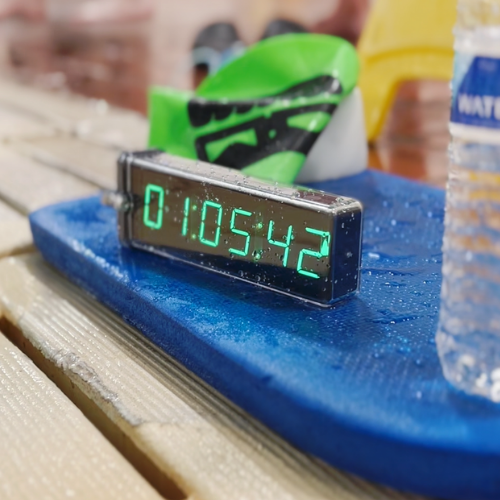- The Swimnerd Newsletter
- Posts
- The Swimmer's Doc: Injury Prevention Strategies and Performance Enhancement
The Swimmer's Doc: Injury Prevention Strategies and Performance Enhancement
"Technique is so, so important, not just to swim fast, but also to make sure that you are pulling, pushing, you know, pressing these, all these different movement patterns properly."
Help preserve our sport's history by becoming a monthly donor to the International Swimming Hall of Fame like us.
Today on the pod we’ve got The Swimmer’s Doc, Sandra Harrell!
Dr. Harrell focuses on the common injuries swimmers face, particularly shoulder issues, and emphasizes the importance of proper strength training, mobility work, and understanding individual biomechanics to prevent and address these issues.
She stresses the importance of maintaining a long and healthy swimming career by mastering basic principles like proper hydration, nutrition, and recovery strategies.
Both Dr. Harrell and Brett highlight the significance of athletes understanding their bodies, recognizing their strengths and weaknesses, and actively engaging in self-reflection to optimize their performance and well-being.
Common Swimming Injuries & Causes:
Shoulder Injuries: The most common issue, primarily caused by repetitive stress, muscle imbalances (overdeveloped front, underdeveloped back), and lack of specific strength training.
"Oftentimes it's also preparation in order to do that specific amount and intensity of training too. So a lot of injuries for swimmers occur as they become more of like the elite, the senior group, right? Your fifteen to eighteen year olds."
Thoracic Outlet Syndrome: A lesser-known but increasingly prevalent issue affecting nerves and blood vessels in the shoulder and neck area, leading to pain, numbness, and weakness. Can be caused by muscle tightness, poor posture, and stress.
"It can be insidious, you know, just gradually occurring, or it can be due to a traumatic incident where, you know, you fall on a shoulder or you dropped something heavy on your shoulder."
Tendonitis: Inflammation of tendons, often caused by overuse, improper biomechanics, and stiffness.
"So your program cannot look like somebody just down the street, who perhaps work, you know, nine to five sitting at a desk who maybe is not very active."
Scoliosis: Curvature of the spine, requiring management strategies like strength training and bracing, and potentially surgery depending on severity.
"Scoliosis is a little bit different, just depending on the severity as well as the type."
Injury Prevention Strategies:
Individualized Strength & Conditioning: Programs tailored to address specific muscle imbalances, mobility limitations, and joint stability needs.
"Somebody, for example, if, you know, I were to divvy up a team and just, you know, have, have a general assessment of somebody who is perhaps maybe more hypermobile. So these are people who have no injuries to begin with."
Proper Technique: Efficient movement patterns reduce stress on joints and muscles.
"This is why where technique matters, right? Technique is so, so important, not just to swim fast, but also to make sure that you are pulling, pushing, you know, pressing these, all these different movement patterns properly"
Early Intervention: Addressing issues promptly prevents them from becoming chronic and more difficult to manage.
"And if you have injuries in club, you can bet that those are going to get worse if you do not address them in high school and in club team."
Key Elements for Longevity:
Hydration: Crucial for performance, nutrient delivery, joint lubrication, and overall bodily functions.
"So there isn't like a magic number necessarily for everyone to be drinking, right? We just have different body types. We live in different environments, some more humid, some more arid, right?"
Nutrition: Adequate protein intake is essential for muscle repair and recovery. Quality of food matters.
"It's the only macronutrient that can help rebuild muscles. And so when athletes, you know, aren't consuming enough protein, you start to see injuries, you start to see burnout, you start to see, you know, symptoms of like overtraining"
Recovery: Prioritizing sleep, active recovery techniques, and stress management.
"Stress management matters, you know, how you, your mental resilience, a big part of what I do with my clients and my athletes and my teams is when, especially when they're injured, it's a lot more, there's a lot of benefit to athlete education about their condition, managing their, you know, recovery expectations, timelines, prognosis, you know"
Importance of Self-Reflection:
Understanding Individual Needs: Identifying what works best for each athlete in terms of food, training, sleep, and mental approach.
"Figuring out who I was and how I operated you know I spent a lot of time studying other people watching my competition you know dealing with understanding training mechanisms and and all that sort of stuff but it wasn't until I really looked inside and figured out who who am I and how do I operate how do I move how do I function"
Mindfulness & Introspection: Taking time to evaluate performance, identify areas for improvement, and make adjustments.
"And so developing, you know, slowing down, I think that's probably the first thing, just slow down, you know, and take, give yourself, you know, five, ten minutes a day at the end of the day, to just start working on being more mindful right?"
Enjoy!
Get in touch with The Swimmer’s Doc, here.
Catch the Full Episode:
Timestamps:
0:00 - Intro: Meet Dr. Sandra Harrell, expert in performance and rehab. 0:22 - Simplifying Complex Topics: Making content accessible. 1:18 - Dr. Harrell’s Story: Early swimming and college injuries. 2:43 - Common Injuries: Shoulders, hips, and their impact. 4:06 - Path to Physical Therapy: From swimmer to specialist. 6:10 - Shoulder Issues: Causes and prevention tips. 7:23 - Strength Training: Injury prevention and better performance. 9:43 - Proprioception: Body awareness in swimming. 12:27 - Muscle Imbalances: Front vs. back muscle development. 14:18 - Mobility Matters: Risks of hyper- and hypo-mobility. 18:02 - Prehab Programs: Individualized injury prevention. 20:22 - Tendonitis Tips: Causes and rehab strategies. 26:37 - Scoliosis & Thoracic Outlet: Managing unique challenges. 33:46 - Hydration: Its critical role in performance. 37:18 - Recovery Basics: Food, protein, and rest. 42:44 - Educating Athletes: Setting realistic recovery goals. 48:42 - College Prep: Strength training for transitions. 50:32 - Self-Reflection: How introspection improves performance. 53:14 - Social Media: Using Dr. Harrell’s content for growth.




